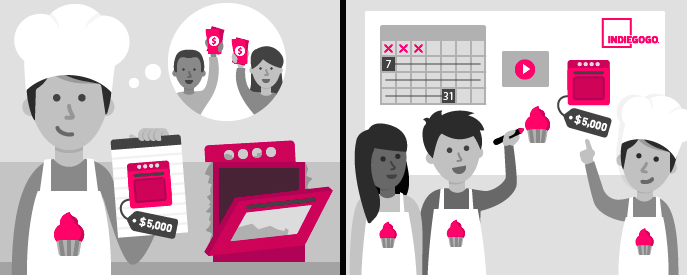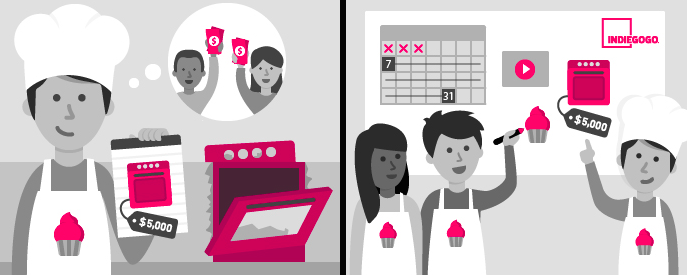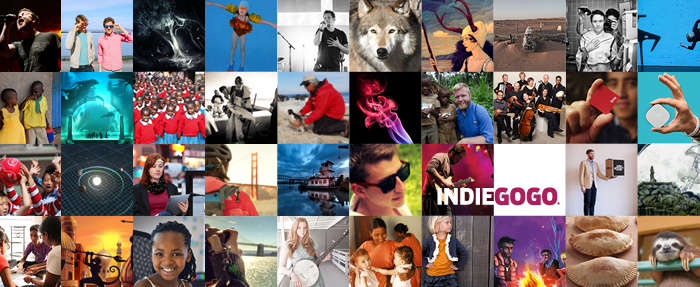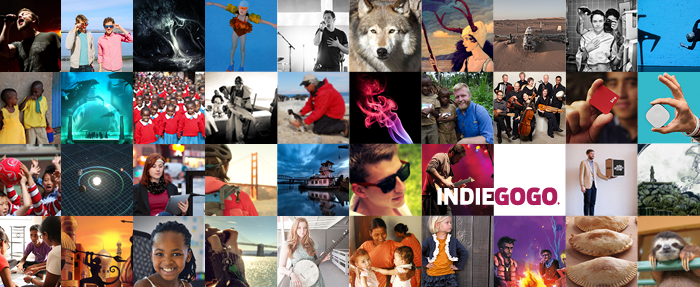Whether you’re on the fence about running an Indiegogo campaign (do it!) or are halfway to goal, collecting as many related tips and hints as possible is always advisable. Here at Indiegogo, we see a lot of lists that make a lot of suggestions, and we want to provide you with what we think are the most relevant.
We’ve curated some great advice to consider before, during, and after your crowdfunding campaign – and there’s so much content, we had to split it into two! This week’s post covers planning and launching your campaign, and next week’s will address maintaining momentum and post-campaign tactics. Let’s go!
PLANNING YOUR CAMPAIGN

1. Research the big hits (and flops)
After an Indiegogo campaign ends, it stays online. These pages are a great resource for you to see what worked well for others – and what didn’t. How did they tell their story? Which of their perks sold out? What social channel did they use? Successful campaigners weigh the outcome of every decision they make, so studying and leveraging their decisions is a smart use of your time.
Similarly, it’s a good idea to learn from campaigns that didn’t reach their goal. Identify the aspects of their projects that performed poorly, and don’t incorporate them into your own. One common element among unsuccessful campaigns is that they’re created – and run – by a single person instead of a team. We’ve said it before: solo is a no-go!
2. Timing is key
Create a calendar that maps out your campaign, from Day 1 to the finish line. Then, add a few weeks on the front end to account for leveraging your social network prior to launch. The more detailed your calendar, the less likely you are to encounter an unexpected hurdle during your campaign.
Also consider an overall timing strategy. Many first-time campaign owners are surprised to discover holidays aren’t necessarily beneficial to campaigns. Similarly, anticipate critical moments for communication and make sure they line up with optimal messaging times. For example, you may want your campaign to end on a workday – as opposed to a Saturday – so your funders will be more likely to be tuned into their computers at work and receive any final messages asking for support.
3. Tell the full story
Your campaign’s two big storytelling opportunities are your video and your copy. These components should not only craft a compelling reason to fund your project, but also answer any question or concern a potential funder might have that would keep them from supporting your cause. The more you can demonstrate you’ve thought through as many aspects of your campaign as possible – from FAQs to stretch goals – the better your audience can visualize where their money will go, which builds trust.
- Save money by working with a single, multitalented filmmaker rather than hiring a crew to produce your video. They’ll gain material for their portfolio and become more familiar with crowdfunding in the process.
- Your video shouldn’t wear out its welcome. The most successful videos run 2-3 minutes in length and work first and foremost on catching attention. Save most of the technical talk for your copy.
- Similarly, your copy should be concise. Because of the internet, information has to be easily digestible – you don’t want to turn readers off with a wall of dense text.
4. Perfect your perks
Campaigns that offer perks raise 143% more money than those that don’t – they have the power to make or break a campaign more than you’d think! The most common advice from experienced campaigners is to make sure your perks strategy is airtight, as the many variables at play (fulfillment, shipping, feasibility) are almost certainly more complex than they first appear.
For example, a campaign page can feature up to 20 perks at a time, though if you offer too many that differ in cost and description only slightly, you may confuse a potential funder to the point that they decide not giving money is the easiest option. You want your campaign as easy to support as possible!
Although $25 perks are the most frequently claimed, funders appreciate a variety of perk options. The trick is to make each distinctly different from the others.
- $100 perks raise the most money and often make up nearly 30% of total funds raised.
- Factor in shipping costs, manufacturing, and time to make sure you’re not losing money with your perks.
- Similarly, consider fulfillment scalability. if 1,000 funders select the same perk, can you really deliver against such demand?
LAUNCHING YOUR CAMPAIGN

1. Play to the crowd
A successful campaign benefits both your cause and your audience. Beyond close friends and family, most people won’t give you money unless it’s clear what your campaign will do for them. Consider the “so what?” test: someone reading your messaging and checking out your perks should be able to answer this question with a clear personal benefit. It’s a given that your campaign will help you, so make sure your funders know how it also benefits them.
If your campaign is mission or cause-based and isn’t structured around enticing perks, leverage your story to convey why someone will feel great about contributing. The more you can make their participation seem like a reward in and of itself, the more likely they are to join, contribute, champion your cause, and make others want in, too.
A launch event is a great way to excite and engage your audience. Fun invitations, food and drinks go a long way toward creating good will. Have a dedicated mobile device ready for on-site funding, and leverage any photos and videos from the event to spread the word through your social channels.
2. Comments are king
Your campaign’s comments tab is an invaluable tool for ensuring you keep your funders happy. Think of it like a customer service kiosk unique to your campaign. Every comment submitted is an opportunity to engage with your community, and you’ll benefit from listening to what they say early on. If an aspect of your campaign isn’t well thought through, or if the entire project seems shaky, this is where you’ll hear about it. Try and respond to all comments in a polite, friendly, and informative manner. Through every bit of dialogue, you’re building a community that will ideally be with you for the long haul.
The level of activity in your comments tab also has a definite impact on your campaign’s gogofactor. The more you listen and engage, the better.
If you receive permission, consider using your campaign’s most enthusiastic and meaningful comments as testimonials for the new product or service your project results in.
Search your social channels for related conversations that you can engage with and potentially attract a wider audience from.
3. Make sharing easy
A designated bit.ly link and hashtag for your campaign go a long way toward enabling others to share your message – and keeping the traffic trackable. Every time you post, write, or otherwise release campaign-related content, include both. Place the link in your email signature, and consider providing pre-written tweets and posts in your emails for your audience to easily copy, paste, and share through their social channels.
Include your campaign’s logo, name and link in related photos and videos. If they’re shared, your project will be immediately apparent.
Ready to move on? Here’s Part II – Maintaining Momentum and Post-campaign Tactics.
Want to dive right in? Download the free Indiegogo Field Guide.






https://www.indiegogo.com/projects/the-bench-bustr-share-the-gym-not-the-germs–2/coming_soon
I am having a problem putting videos and images on my Indiegogo page. Unfortunately, I’m not very tech savvy. Can anyone assist me with this. Thanks.
Get onboard our journey. Handmade wooden eyewear, made in Sweden
https://igg.me/at/wood3n/x/13838329
any tips > https://www.indiegogo.com/projects/help-us-upgrade-our-studio-to-release-more-albums#/
I jоinеd а bit mоrе thаn а wееk аgо аnd lаst wееl I hаd 6 winning trаdes in five days. I am vvery happy and look forward to this week https://fb.me/2D1uYiLsp
Grow food anywhere with SmallFolders.
https://igg.me/at/smallfolders/x/12716695
Check out “I would like to buy a food truck.” on Indiegogo https://igg.me/at/iNTiEtQDRio/shre/12604283
Check out my campaign on indiegogo
https://igg.me/at/6nz-3-6-OKs
Check out our film campaign and pick your perk! 🙂
https://igg.me/at/SuPEiyimlhE/x
https://www.indiegogo.com/projects/help-create-2706-mystery-haunted-house-attraction/x/11775782#/story
Help our friend Julian to reach his goal. https://life.indiegogo.com/fundraisers/education-fund–33
Help us with our campaign: https://igg.me/at/my-boat/x/8863138
Thanks!
Help me promote and fix things please someone
Help! How do I include a reward where the customer chooses the amount?
This doesn’t help… I have done all (or nearly all) of this and haven’t raised money anywhere near my goal. I will never again use indiegogo for a campaign. They don’t help advertise or share it on social media, and I have shard it on my social media sites daily and have not received enough to even cover expenses of the short film I want to do. I am very dissatisfied and will I guess try and use kick starter next time. Or some other Crowd funding site.
What a great cause! Congrats! way to go!!
Hello, my name is Larry Friedman and I currently experiencing the worst crisis of my life. I have been unemployed for more than a year and my unemployment benefits ran out several months ago. I am currently a state vocational rehabilitation client and they are assisting in my job search. In the meantime I am drastically behind on my rent and am facing certain eviction and homelessness. I need to raise $2,000 asap. I have no family and no one to rely on. I just need survive until I am employed again. If anyone has any doubt about me telling the truth please feel free to contact my landlord: Southern Oaks Apartments, Stone Mountain, GA 770-469-5107. Sharon is the office manager. You can send the money directly to the landlord or to my paypal account at Larry Friedman email bujudude@yahoo.com Thank you for reading this.
So if solo is a no go, then what are people with no team and no money to put together a team supposed to do? Just magically get a team? LOL
Check out bringing technology like 3d printing to students on #indiegogo! https://igg.me/p/982430
Very helpful, thank you, now to make a few changes to my campaign.
Great sire
Very helpful! Thanks!
Good advice. Thank you Go-Team.
So much great info….thanks.
Great ideas that I never considered. thanks for the advise.
Great Article on crowdfunding campaigns!
I am sorry that I did not have this information at the start of my campaign. I think we would’ve done better.
is it advisable to use the service of some agencies to produce professional press release to create traffic to boost the apearance of the campaign on the platform for successful funding?
Thank you for this advice.I am SO LOST, as….did I do it correctly..After we launch a campaign is it to late to fix things? As far as adding a video, can I still do that, after launching? I would liked to be able to tell more of my story, then 500 words allowed..
Thanks for your help. But just wondering how important to have pre-funders line to up to jump start a campaign? Seems a lot of campaigns raise an unbelievable amount of money in the first 24 hrs. Seems a lot for what is essentially a mass cold call.